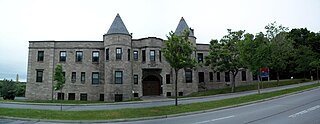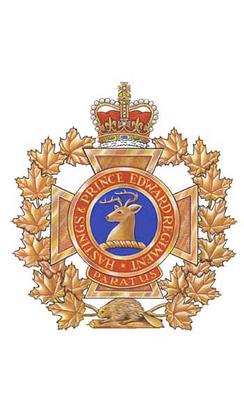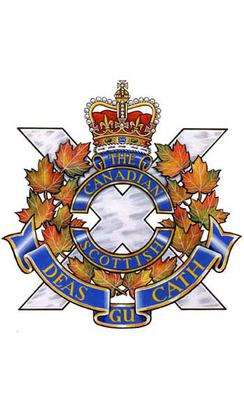
The Royal Regiment of Canadian Artillery is the artillery personnel branch of the Canadian Army.
The 7th Toronto Regiment, Royal Canadian Artillery is a militia regiment of 4th Canadian Division's 32 Canadian Brigade Group,

The 2nd Field Artillery Regiment, RCA is a Royal Canadian Artillery reserve regiment. It is located in Montreal and shares its headquarters with The Royal Canadian Hussars (Montreal) at the Côte-des-Neiges Armory.

The 1st (Halifax-Dartmouth) Field Artillery Regiment, RCA, is a Canadian Army reserve artillery regiment. It is located in Halifax, Nova Scotia, at 73 Hobson Lake Drive. The unit consists of two batteries, 51st and 84th Field Batteries. There are two units located within 1st (Halifax-Dartmouth) Field Artillery Regiment. One is in Halifax and the other is the 84th Independent Field Battery located in Yarmouth NS. Both share the same Commanding Officer.

The Hastings and Prince Edward Regiment is a Primary Reserve infantry regiment of the Canadian Army. The regiment is part of 33 Canadian Brigade Group, one of four brigade groups of 4th Canadian Division. The regimental headquarters and one company are at 187 Pinnacle Street in Belleville and on Willmott Street in Cobourg, with another rifle company in Peterborough. The Peterborough Armoury houses what was traditionally B Company or Moro Company. Moro Company also serves as the headquarters for the regiment’s Assault Pioneer Platoon. Normally, the regiment deploys as a composite, Ortona Company, while the headquarters and administration form Somme Company.

The Canadian Scottish Regiment (Princess Mary's) is a Primary Reserve infantry regiment of the Canadian Army based on Vancouver Island in British Columbia.

15th Field Artillery Regiment, RCA, is a Primary Reserve Royal Canadian Artillery (RCA) regiment based in Vancouver, British Columbia, at the Bessborough Armoury. 15th Field Regiment is part of the 39 Canadian Brigade Group of 3rd Canadian Division.
Beginning with establishment of Fort Calgary in 1875, the city of Calgary, Alberta, has had some degree of permanent military presence throughout its history.

The West Riding Artillery was formed as a group of volunteer units of the British Army in 1860. Its units later formed the divisional artillery of the West Riding Division of the Territorial Force in World War I and World War II. The West Riding Artillery's lineage is continued in a battery of today's Army Reserve
The 30th Field Artillery Regiment, RCA is a bilingual Canadian Army artillery regiment located in Ottawa, Ontario, and is allocated to 33 Canadian Brigade Group, 4th Canadian Division. The unit parades at a new complex at the Canadian Forces Support Unit (Ottawa) - Uplands Site following the collapse of their former location at CFRB Dows Lake under the weight of snow in 2009. The unit performs ceremonial gun salute duties when required in the National Capital area, and is a field unit equipped with 105 mm Howitzers, C3.

The 2nd/10th Dragoons was a militia regiment of the Canadian Army, based in the Niagara, Wentworth, and Brant regions of southern Ontario. It was formed in 1936 by amalgamating the 2nd and 10th Dragoons, both of which had served previously as cavalry units in the Canadian militia. After World War II the regiment was converted into an anti-aircraft artillery unit. In 1962 the regiment was converted into a field howitzer unit and in 1968, amid a downsizing of the Canadian Armed Forces, the regiment was reduced drastically before eventually being completely disbanded in the mid-1990s. The regiment is currently on the Supplementary Order of Battle.
The Yorkton Regiment was an infantry regiment of the Non-Permanent Active Militia of the Canadian Militia. It was formed in 1924, when The North Saskatchewan Regiment (1920–1924) was reorganized into four separate regiments, and was located in Yorkton, Saskatchewan. In 1936, the regiment was converted from infantry to artillery and currently exists today as the 64th Field Battery, RCA.
The 50th Field Artillery Regiment, Royal Canadian Artillery was a Canadian Army Reserve artillery regiment based in Peterborough, Ontario. The regiment exists "on paper" on the Supplementary Order of Battle.
The 116th Independent Field Battery, Royal Canadian Artillery is a Canadian Army Reserve independent artillery battery based in Kenora, Ontario, which forms part of the 3rd Canadian Division's 38 Canadian Brigade Group. The battery parades at the Kenora Armoury, 800-11th Avenue North.

A number of militia artillery batteries were raised in Prince Edward Island from 1875. When the First World War broke out, three battery-sized units were raised and deployed from the island as part of the Canadian Expeditionary Force.

The 1st Devonshire Artillery Volunteers and its successor units served in the British Army's Reserve Forces from 1859 to 1961. During World War I it carried out garrison duty in British India but went on to see active service in the Third Anglo-Afghan War. Converting to an air defence role before World War II its units participated in the Norwegian campaign and the Dunkirk evacuation, the Battle of Britain and then the campaigns in North Africa, Italy, and Burma
The 1st Cinque Ports Artillery Volunteers was a part-time unit of the British Army's Royal Artillery from 1860 to 1956. Raised as coastal defence artillery, the unit later served as field artillery in Mesopotamia during World War I, and as anti-aircraft artillery during the Blitz and in the Middle East during World War II.
The Cheshire Artillery Volunteers was a brigade of Volunteer artillery units raised in the county of Cheshire in the mid-19th century. Their successors served as field artillery in Palestine during World War I and as anti-aircraft (AA) gunners in the Middle East in World War II. They continued in the air defence role in the Territorial Army until 1955.
The Saskatoon Light Infantry was an infantry regiment of the Non-Permanent Active Militia of the Canadian Militia. The regiment was formed in 1924, when The North Saskatchewan Regiment (1920–1924) was reorganized into four separate regiments. In 1955, the regiment was amalgamated with The Prince Albert and Battleford Volunteers to form The North Saskatchewan Regiment.
The 10th Field Artillery Regiment, RCA is an artillery regiment of the Canadian Army Primary Reserve. Based in Regina, Saskatchewan, the regiment forms part of the 38 Canadian Brigade Group of the 3rd Canadian Division.










